What to do if Fronius Welding System tS3 error occurs?
- AAmanda BrownSep 12, 2025
If the Fronius Welding System displays a tS3 error, it indicates overtemperature in the power source's secondary circuit. Allow the power source to cool down.
What to do if Fronius Welding System tS3 error occurs?
If the Fronius Welding System displays a tS3 error, it indicates overtemperature in the power source's secondary circuit. Allow the power source to cool down.
What to do if Fronius Welding System tSt error occurs?
If the Fronius Welding System displays a tSt error, it indicates overtemperature in the power source control circuit. Allow the power source to cool down.
Details the meaning of danger, warning, caution, and note symbols used in the manual.
Covers device manufacturing standards, operator obligations, and safety notice maintenance.
Specifies the intended use of the device and lists prohibited applications like thawing pipes.
Outlines the responsibilities of operators and personnel regarding safety and instruction.
Details risks from welding (sparks, radiation, fields, current) and required protective clothing.
Covers dangers from toxic fumes, flying sparks, flammable vapors, and electrical risks.
Explains dangers of electric shock, live parts, cable safety, and double open circuit voltage.
Warns about moving parts, welding wire risks, high temperatures, and special area provisions.
Provides safety instructions for handling and securing shielding gas cylinders to prevent explosions.
Emphasizes operating the device only with functional safety devices and never bypassing them.
Stresses using original parts, avoiding modifications, and performing safety inspections.
Provides notes on software updates affecting functions and safety warnings for operation.
Provides critical safety warnings regarding incorrect operation and handling during installation.
Details mains voltage requirements, fuse protection, and electrical installation considerations.
Highlights electrical shock risks and the importance of air filters for IP 23 protection.
Warns about risks of gas cylinder toppling and provides instructions for securing them.
Details procedures for grounding the workpiece and connecting the welding torch, including HF cautions.
Provides crucial safety warnings before operating TIG functions and refers to setup menu.
Provides safety warnings and explains how to navigate TIG welding parameters on the display.
Details setting ranges and factory settings for Starting current, Upslope, and Main current parameters.
Covers parameters for Reduced current, Downslope, and Final current, including their units and ranges.
Details the steps for HF ignition, including safety precautions and gap settings.
Describes the process for igniting the arc by touching the workpiece with the tungsten electrode.
Explains functions that automatically cut out the power source upon arc break or failed ignition.
Provides safety warnings and explains how to navigate MMA welding parameters.
Details parameters like Starting current and Main current for rod electrode welding.
Explains selecting MMA mode, process types (AC/DC), and adjusting welding parameters.
Explains how the anti-stick function prevents electrode sticking and burn-out.
Provides safety warnings and explains parameter display navigation for selected welding jobs.
Details how to save, retrieve, optimize, and delete welding jobs via the menu.
Guides on selecting modes, parameters, and naming jobs for saving welding settings.
Covers Pulse frequency, Duty Cycle, Ground current, and Starting/Final current time parameters.
Details AC frequency, AC current offset, and AC setup 2nd parameters.
Details Pre-flow, Post-flow Imin, Post-flow Imax, and Gas quantity parameters.
Details Wirefeed speed 2, Start-delay, End-delay, and Wire threading parameters.
Details the step-by-step process for calibrating the push-pull unit, including safety precautions.
Lists service codes, their causes, and remedies for issues during push-pull unit calibration.
Covers Anti-stick and Char. parameters, including graphical explanations of characteristics.
Provides step-by-step instructions for deleting stored welding jobs.
Guides on performing a factory reset, noting that personal settings are lost but jobs are preserved.
Provides general safety warnings for troubleshooting and information on displayed service codes.
Lists common error codes, their causes, and recommended remedies.
Addresses issues like power source not functioning, no welding current, and torch trigger problems.
Emphasizes minimal care needs but vital points for long-term usability and safety.
Details the meaning of danger, warning, caution, and note symbols used in the manual.
Covers device manufacturing standards, operator obligations, and safety notice maintenance.
Specifies the intended use of the device and lists prohibited applications like thawing pipes.
Outlines the responsibilities of operators and personnel regarding safety and instruction.
Details risks from welding (sparks, radiation, fields, current) and required protective clothing.
Covers dangers from toxic fumes, flying sparks, flammable vapors, and electrical risks.
Explains dangers of electric shock, live parts, cable safety, and double open circuit voltage.
Warns about moving parts, welding wire risks, high temperatures, and special area provisions.
Provides safety instructions for handling and securing shielding gas cylinders to prevent explosions.
Emphasizes operating the device only with functional safety devices and never bypassing them.
Stresses using original parts, avoiding modifications, and performing safety inspections.
Provides notes on software updates affecting functions and safety warnings for operation.
Provides critical safety warnings regarding incorrect operation and handling during installation.
Details mains voltage requirements, fuse protection, and electrical installation considerations.
Highlights electrical shock risks and the importance of air filters for IP 23 protection.
Warns about risks of gas cylinder toppling and provides instructions for securing them.
Details procedures for grounding the workpiece and connecting the welding torch, including HF cautions.
Provides crucial safety warnings before operating TIG functions and refers to setup menu.
Provides safety warnings and explains how to navigate TIG welding parameters on the display.
Details setting ranges and factory settings for Starting current, Upslope, and Main current parameters.
Covers parameters for Reduced current, Downslope, and Final current, including their units and ranges.
Details the steps for HF ignition, including safety precautions and gap settings.
Describes the process for igniting the arc by touching the workpiece with the tungsten electrode.
Explains functions that automatically cut out the power source upon arc break or failed ignition.
Provides safety warnings and explains how to navigate MMA welding parameters.
Details parameters like Starting current and Main current for rod electrode welding.
Explains selecting MMA mode, process types (AC/DC), and adjusting welding parameters.
Explains how the anti-stick function prevents electrode sticking and burn-out.
Provides safety warnings and explains parameter display navigation for selected welding jobs.
Details how to save, retrieve, optimize, and delete welding jobs via the menu.
Guides on selecting modes, parameters, and naming jobs for saving welding settings.
Covers Pulse frequency, Duty Cycle, Ground current, and Starting/Final current time parameters.
Details AC frequency, AC current offset, and AC setup 2nd parameters.
Details Pre-flow, Post-flow Imin, Post-flow Imax, and Gas quantity parameters.
Details Wirefeed speed 2, Start-delay, End-delay, and Wire threading parameters.
Details the step-by-step process for calibrating the push-pull unit, including safety precautions.
Lists service codes, their causes, and remedies for issues during push-pull unit calibration.
Covers Anti-stick and Char. parameters, including graphical explanations of characteristics.
Provides step-by-step instructions for deleting stored welding jobs.
Guides on performing a factory reset, noting that personal settings are lost but jobs are preserved.
Provides general safety warnings for troubleshooting and information on displayed service codes.
Lists common error codes, their causes, and recommended remedies.
Addresses issues like power source not functioning, no welding current, and torch trigger problems.
Emphasizes minimal care needs but vital points for long-term usability and safety.
| Brand | Fronius |
|---|---|
| Model | MagicWave 2200 |
| Category | Welding System |
| Language | English |
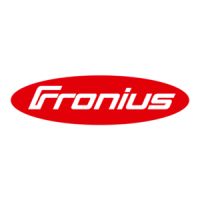
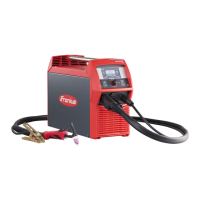



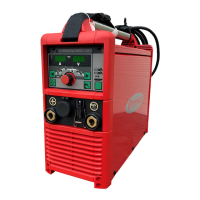



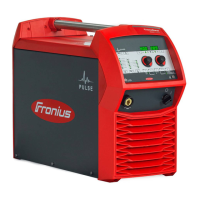

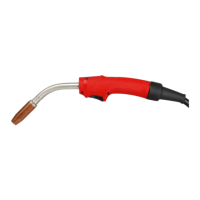
